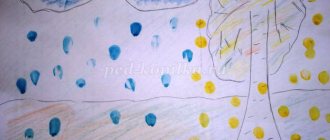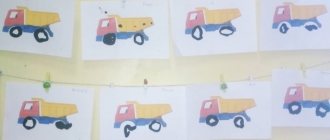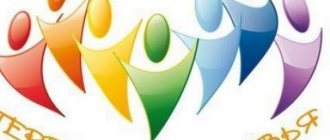MAGAZINE Preschooler.RF
Summary of a lesson on developing a healthy lifestyle in the first junior group “The bears came to visit us”Municipal autonomous preschool educational institution combined type kindergarten "Fairy Tale" Ak-Dovurak, Republic of Tyva
Educational areas: physical education, communication, cognition.
Goals:
- develop children’s physical activity, create a desire to engage in physical education; introduce children to objects in their immediate environment: a bear toy; learn to describe a toy (name parts, size, characteristics), compare large and small toys;
- cultivate a love for animals.
Equipment: two teddy bears of different sizes, a handkerchief, pine cones, a basket, a tape recorder, health tracks.
Progress of the lesson.
1. Organizational moment.
-Guys, stand in a circle. Today some guests came to visit us for class. Let's say hello.
Now, children, let's play the game "Carousel"
Barely, barely, barely, barely, The carousels began to spin, And then around, around, Everyone ran, ran, ran!
(run in a circle 2-3 times)
Now we stop and rest (exercise - inhale, exhale).
-Well done kids, we had a great ride.
-Children, look here, do you see the path?
(Points to the massage paths.)
- We'll follow it.
Children walk one after another along the massage paths.
2. Main part. Looking at a toy.
- Guys, another guest came to our lesson. He hid under a handkerchief. First, children, guess the riddle about him.
The owner of the forest wakes up in the spring. And in winter, under the blizzard howl, he sleeps in a snowy hut.
(bear)
-Learned! Who came to visit us? Well done!
-Children, come closer to the bear, stroke its fluffy fur, touch its ears, look at its eyes, nose, soft paws, and tummy. (children look at the bear and touch it)
-What bear? (the teacher encourages the children to speak with her).
-Is our bear fluffy?
-His ears are small and soft?
-His paws are soft?
-Is your tummy soft?
-Is the tail soft and small?
-Are your eyes round, like buttons?
-Now name the parts of the toy? (head, belly, paws, back, tail, nose).
3. Physical education minute
The clumsy bear is walking through the forest, collecting cones, singing a song, suddenly a cone fell, right on the bear’s forehead. The bear got angry and stamped his foot
4. Comparison of bears of different sizes.
- Guys, the bear wants to tell me something. (listens to the bear)
-Mishka said that he came alone, but with a friend. His friend is also hiding. Let's see who he is. (takes out a toy bear from under a small scarf).
-Who is this, guys? (Bear.)
Next, pointing first to the small bear, then to the big one, he asks a question;:
-Is this bear the same?
-This bear is big, and this one is small. The big bear has big ears, the little bear has small ears...
5. Game “Collect cones”
-Children and bears love to play with pine cones. Let's collect cones for the bears in a basket. (Before class, the teacher had already scattered the pine cones on the carpet.)
Children collect cones in a basket while listening to music. When the children have already collected, the teacher brings a box with a bow and says:
-Well done, children, the bear is very glad that you collected pine cones for them and gives you gifts in gratitude. (The teacher takes candy from the box and distributes it to the children.)
-Now it's time to say goodbye to the bears. Let's say to the bears: "Goodbye!"
6. Reflection.
-Who did we play with in class?
(before goodbye, the teacher suggests playing with the bears some more: cooking them porridge, putting on aprons, feeding them porridge from a spoon.)
Methodological literature used:
- Complex classes according to the program “From birth to school” edited by N.E. Veraksy, T.S. Komarova, M.A. Vasilyeva. Publishing house "Teacher" - 2013
- Physical education classes in kindergarten. E.F. Zhelobkovich. Second junior group. -M.: Publishing house “Scriptorium 2003” , 2009.
| Next > |
Lesson summary on the topic: Healthy lifestyle in the nursery group
Summary of a lesson on developing a healthy lifestyle in a nursery group on the topic: “Our helpers are ears, nose, mouth and eyes”
Objectives: 1. To introduce children to the organs of hearing, smell, vision and their importance in human life. 2. Develop the ability to care for your organs of hearing, vision, touch and smell. 3.Form logical thinking and aesthetic taste. 4.Develop creative imagination and musical taste. Demonstration material. 1. Mirror, sun, small suns, small mirror.
2. Big and small bear, big and small car, big and small doll. 3. Apple, carrots, candy, bread, onion, orange, garlic, perfume. 4. Screen, rattle, drum, bell Progress of the lesson
Educator:
Our sun woke up, Smiled at us affectionately This is our sun with you.
(The teacher shows the sun to the children.) Our mascot. What is your motto? Children:
“We want to be healthy”
Educator:
Oh, guys, I hear the bell ringing.
Let's see who came to visit us? Who is this? Children:
Autumn!!!
Educator:
Yes, guys - it's Autumn!
Oh, look what autumn has brought us. Children
: mirror.
Educator:
Well done!
Right! Of course, a mirror. Let's sit down and listen to what the guest wants to tell us. Autumn:
Hello, my dear guys!!!
Look what an interesting gift I brought you! Tell me, what is a mirror for? Children:
look at yourself in it.
Autumn:
Our light, mirror, soot and show the whole truth.
Let's look in the mirror and see what we see there. Children
: our reflection
Autumn:
What’s on our face?
Let's show the mirror our ears, noses, eyes, mouths. Educator:
Oh, how interesting!!
Thank you Autumn! Guys, let's invite Autumn to play with us. (Children take their seats, Autumn begins to sit down nearby). Yes, we have eyes. How many eyes do we have? Children:
two.
Educator:
Let's look at our eyes in the mirror again. (Misha, Masha, Sonya children approach the mirror one by one).
Why do we need eyes? Children:
to watch.
Autumn
(removes the mirror): Let's play a game.
“Let's compare.” (On the table there is a small bear, a small doll, a small car. Then he takes out a large bear, a large doll and a car.) Guys, tell me, how do the toys differ from each other? Children:
some toys are big, others are small.
Autumn:
Oh, what great guys!!!
Educator:
Well done, you did it all, you proved that you need eyes to look.
To prevent your eyes from hurting, you need to do eye exercises. Exercise for the eyes. The eyes will smile at the sun, look down at the grass and back up into the heights, looking back and forth. We will never get tired. We close our eyes tightly and open them wide. (The bell rang again) Educator:
Oh, guys, Autumn is calling us again to come to the table.
And look in the mirror. Autumn:
We take the mirror again, what do we see in it again?
Educator: Guys, what else do you see on your face? Children:
nose.
Educator:
How many noses do you and I have?
Children:
one.
Educator:
Why do we need spouts?
Children:
to breathe.
Educator:
Let's prove it.
Cover your nose with one hand and your mouth with the other hand. And try to breathe. Does not work. You and I have proven that we need a nose to breathe. Autumn:
Well done!
And now we will play with you. A game. Nose, nose, guess what it smells like, do you find out? (Take garlic, perfume, orange, candy. Children guess) Educator:
So, children, why do we need a nose?
(breathe, smell). And so that our nose does not hurt, we need to do gymnastics for the nose. Gymnastics for the nose. We will take a deep breath of air With our mouth we will exhale it One-inhale, two - inhale One-inhale, two - inhale We will stroke the wings of the nose From above, from below And we will inhale one more time (Again we hear the ringing of the bell and approach the table). Autumn:
We take the mirror again, what else do we see in it”
Children:
ears.
Educator:
How many ears?
Children:
two.
Educator:
What do we need them for?
Children:
to hear.
Autumn:
Come to me quickly, now let’s play the game “Whose Sound.”
A game. (a bell, a rattle, and a drum ring in turn behind the screen). Educator:
You guessed everything correctly, children, our ears are novices.
And so that our ears can hear well, let's do exercises for our ears. Ear charger. We'll rub our palms together, boldly we'll take the ears, we'll pinch them from top to bottom, we'll go through them from bottom to top again. (We hear the bell ringing again and approach the table). Autumn:
“We take the mirror again, what else do we see in it?”
Children:
mouth.
Educator:
Why do we need a mouth?
Children:
talk, eat.
Educator:
And at the mouth, what helpers are there?
Children:
lips, teeth, tongue.
Educator:
Yes, children, we have lips, teeth and a tongue... why do we need teeth ((to chew). And the tongue (it helps us speak and recognize what food we eat).
Autumn:
Guys, I have another one a great game for you, let's play? I'll put food in your mouth, and you guess what it tastes like. Game “Guess the taste.” (apple, carrot, candy, bread, onion on toothpicks). (Sit down on chairs)
Autumn :
Well done!! I played so well with you! And here are some gifts from me for your hospitality!!! My little helpers are the suns. Oh, guys, what is this? What happened to the suns? What do they lack? (sad)
Educator:
Don't worry, Autumn! We'll fix everything now. Guys, let's help Autumn and give back to the suns what they are missing. What are the suns missing?
Children:
eyes, nose, ears, mouth. (Children stick the missing elements to the suns).
Autumn:
(Autumn takes out another gift - a small mirror and gives it to the teacher.) They did a wonderful job. They returned everything to their places.
And I have one more gift. This is a gift for you!!! Educator:
Thank you, Autumn! Guys, let's invite Autumn to play with us and the sunbeams. (Autumn plays with the teacher and children.)
We recommend watching:
Joint activities in an early age group. Synopsis of a lesson with children in the first year of life Synopsis of a joint educational activity for children of the 1st junior group “Winter-Winter” Complex thematic lesson in an early age group together with mothers
Similar articles:
Lesson summary for an early age group. Cockerel
Lesson summary for an early age group. Dandelion
Summary of a game developmental lesson in an early age group on the topic: Rays of the sun
Game development activity in kindergarten for children of the third year of life
Lesson summary for the first early age group on the topic: Toys
Long-term plan for healthy lifestyle for the first junior group
Galina Mansurova
Long-term plan for healthy lifestyle for the first junior group
Long-term plan for healthy lifestyle in the first junior group
September
1 week and 2 week
- diagnostics
3 week
Subject:
"Sorceress Water"
Tasks:
Introduce children to the properties of water and its necessity in human life. To consolidate and clarify children's knowledge about why people use water in everyday life.
1. Didactic exercise “Water, water, wash my face.”
4 week
Subject:
“Cleanliness is the key to health.”
Tasks:
Bring children to the concept of how important it is to maintain cleanliness. Develop cultural and hygienic skills.
1. Reading S. Ya. Marshak “Moidodyr”.
October
1 Week
Subject:
"Clean hands"
Tasks:
To form children's ideas about hand skin care. Teach to take care of their cleanliness.
1. Conversation “Why should you wash your hands before eating?”
2. Learning the algorithm for washing hands with soap.
2 week
Subject:
"Taking care of ourselves"
Tasks:
Clarify and expand children's knowledge about personal care items.
Cultivate neatness and proper attitude towards your appearance.
1. Didactic game “Choose the right one” (personal care items).
2. Reading A. Barto “The Dirty Girl.”
3 week
Subject:
"That's what I am"
Tasks:
Introduce children to the structure of the body. Help your child understand their gender identity.
1. Didactic game “Name what it is.”
4 week
Subject:
"Personal hygiene"
Tasks:
Teach the rules of personal hygiene and encourage children to perform them independently.
1. Didactic game “Bathing a doll.”
November
1 Week
Subject:
"Eyes-hints"
Tasks:
To give children basic ideas about eyes and how to
take care of your eyesight.
1. Didactic game “What is missing.”
2. Consultation “How to preserve vision.”
2 week
Subject:
"My nose"
Tasks:
To give children a basic understanding of the nose and the rules of caring for
him.
1. Conversation “Why do you need to breathe through your nose?”
2. Didactic game: “Guess the smell.”
3 week
Subject:
“What are ears needed for?”
Tasks:
To form an idea of the organ of hearing – the ears; develop an understanding of the need for ear care.
1. Didactic game “Guess what I’m playing.”
4 week
Subject:
"What is leather"
Tasks:
Introduce the importance of skin to humans. Cultivate curiosity about your body.
1. Research activity “Looking at the skin on your hands through a magnifying glass.”
December
1 Week
Subject:
"Visiting Aibolit"
Tasks:
To form children’s knowledge about the concept of “health”, caring
attitude towards yourself, towards your life.
1. Watching the cartoon “Doctor Aibolit.”
2. Didactic game “You can - you can’t.”
2 week
Subject:
"Dress warmly"
Tasks:
Expand children's knowledge about necessary items of clothing in winter
time to maintain your health.
1. Looking at the pictures “Warm clothes and shoes.”
2. Lotto “Walk” (according to the seasons).
3 week
Subject:
“Vitamins strengthen the body”
Tasks:
Introduce the concept of “vitamins”, consolidate knowledge about the need for vitamins in the human body.
1. Conversation “Tasty and tasteless vitamins.”
4 week
Subject:
"Health and Illness"
Tasks:
Cultivate a caring attitude towards your health and wellness
those around you.
1. Conversation “How to take care of your health.”
2. Watching the cartoon “What is good and what is bad?”
January
2 week
Subject:
"Necessary Medicines"
Tasks:
Provide basic information about medications.
1. Conversation “Bitter medicines”.
3 week
Subject:
"Watch out for the flu!"
Tasks:
Teach to take care of your health, introduce children to the characteristic signs of illness and prevention.
1. Conversation “Beware of the flu!”
2. Role-playing game “The bear is sick.”
4 week
Subject:
"Is it possible to eat snow"
Tasks:
Develop skills to take care of your health.
1. Conversation “Sore throat.”
2. Poem “The Crow Ate the Snow.”
February
1 Week
Subject:
"Medicines and vitamins"
Tasks:
Form in children the habit of not touching medications and vitamins without
adult permission.
1. Reading the poem by G. Shalaeva “Don’t eat unfamiliar pills.”
2 week
Subject:
"Healthy foods"
Tasks:
To provide knowledge about healthy foods that contain vitamins,
educate children about nutritional culture.
1. Didactic game “Foods that help strengthen the body.”
3 week
Subject:
"Edible - inedible"
Tasks:
Formation of knowledge about the danger posed by strangers
products".
1. Didactic game “Do’s and Don’ts.”
4 week
Subject:
"Sport is health"
Tasks:
Develop a desire to exercise.
1. Review of the album “Sports and Children.”
March
1 Week
Subject:
"Kinds of sports".
Tasks:
Develop interest in various sports.
1. Lotto “Sports”.
2 week
Subject:
“I can - I can’t”
Tasks:
Focus children's attention on your skills and physical
the capabilities of your body; develop self-confidence.
1. Didactic game “Let’s help our Masha.”
3 week
Subject:
"Posture"
Tasks:
Continue to teach children to take care of their health, their
posture.
1. Didactic game: “Smooth backs.”
4 week
Subject:
“These are the icicles!”
Tasks:
Teach children not to put icicles or pieces of ice in their mouths; give knowledge about what
if you lick or eat them, you will get a sore throat.
1. Conversation “About icicles.”
2. Experiments with ice, icicles, conclusions.
April
1 Week
Topic: “Vegetables and fruits are healthy foods. Vegetables"
Tasks:
Give an idea of healthy and unhealthy foods.
1. Lotto “Vegetables - Fruits”
2 week
Subject:
“Vegetables and fruits are healthy foods. Fruits"
Tasks:
To consolidate knowledge about fruits and their importance in nutrition.
1. Didactic game “Choose the color of the fruit.”
3 week
Subject:
“Sun, air and water are our best friends”
Tasks:
Introduce children to an integral part of a healthy lifestyle - hardening, the main means of hardening: sun, air and water.
1. Reading V. Suslov “About Yura and physical education.”
4 week
Subject:
"We're going for a walk"
Tasks:
Arouse interest in walks, a desire to play various games outdoors, and develop physical activity.
1. The teacher’s story about the benefits of walking, about why it is useful to be in the fresh air.
May
Week 1 and week 2 – diagnostics.
3 week
Subject:
"Daily regime"
Tasks:
Talk about the importance of following a daily routine. Make it clear that following a daily routine improves the health of every person.
1. Didactic game “When does this happen?”
2. Reading A. Vishnevskaya “In the morning the sun woke up.”
4 week
Subject:
"The child and his health"
Tasks:
Clarify the rules for maintaining health, create interest in
own body, well-being, mood associated with health.
1. Looking at photographs “We have grown and become strong and strong.”
2. Conversation about health.


